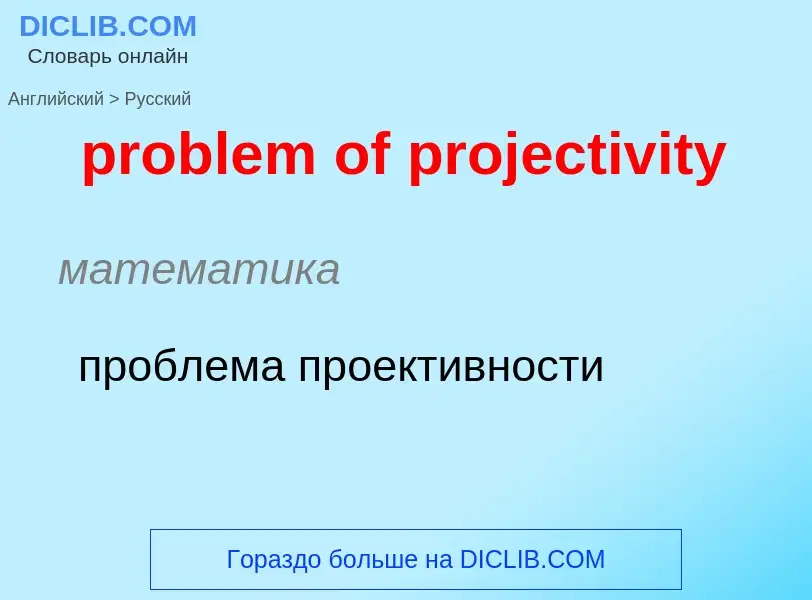Перевод и анализ слов искусственным интеллектом ChatGPT
На этой странице Вы можете получить подробный анализ слова или словосочетания, произведенный с помощью лучшей на сегодняшний день технологии искусственного интеллекта:
- как употребляется слово
- частота употребления
- используется оно чаще в устной или письменной речи
- варианты перевода слова
- примеры употребления (несколько фраз с переводом)
- этимология
problem of projectivity - перевод на русский
математика
проблема проективности
математика
задача о ранце
2) задача о распределении (напр. ресурсов)
математика
задача о назначениях
математика
задача о секретаре
задача о выборе наилучшего объекта
математика
задача о гостях
Определение
.
Википедия
In physics and astronomy, Euler's three-body problem is to solve for the motion of a particle that is acted upon by the gravitational field of two other point masses that are fixed in space. This problem is exactly solvable, and yields an approximate solution for particles moving in the gravitational fields of prolate and oblate spheroids. This problem is named after Leonhard Euler, who discussed it in memoirs published in 1760. Important extensions and analyses were contributed subsequently by Lagrange, Liouville, Laplace, Jacobi, Darboux, Le Verrier, Velde, Hamilton, Poincaré, Birkhoff and E. T. Whittaker, among others.
Euler's problem also covers the case when the particle is acted upon by other inverse-square central forces, such as the electrostatic interaction described by Coulomb's law. The classical solutions of the Euler problem have been used to study chemical bonding, using a semiclassical approximation of the energy levels of a single electron moving in the field of two atomic nuclei, such as the diatomic ion HeH2+. This was first done by Wolfgang Pauli in his doctoral dissertation under Arnold Sommerfeld, a study of the first ion of molecular hydrogen, namely the hydrogen molecule-ion H2+. These energy levels can be calculated with reasonable accuracy using the Einstein–Brillouin–Keller method, which is also the basis of the Bohr model of atomic hydrogen. More recently, as explained further in the quantum-mechanical version, analytical solutions to the eigenvalues (energies) have been obtained: these are a generalization of the Lambert W function.
The exact solution, in the full three dimensional case, can be expressed in terms of Weierstrass's elliptic functions For convenience, the problem may also be solved by numerical methods, such as Runge–Kutta integration of the equations of motion. The total energy of the moving particle is conserved, but its linear and angular momentum are not, since the two fixed centers can apply a net force and torque. Nevertheless, the particle has a second conserved quantity that corresponds to the angular momentum or to the Laplace–Runge–Lenz vector as limiting cases.
The Euler three-body problem is known by a variety of names, such as the problem of two fixed centers, the Euler–Jacobi problem, and the two-center Kepler problem. Various generalizations of Euler's problem are known; these generalizations add linear and inverse cubic forces and up to five centers of force. Special cases of these generalized problems include Darboux's problem and Velde's problem.











![elastically]] isn't. elastically]] isn't.](https://commons.wikimedia.org/wiki/Special:FilePath/3bodyproblem.gif?width=200)
![The circular restricted three-body problem is a valid approximation of elliptical orbits found in the [[Solar System]], and this can be visualized as a combination of the potentials due to the gravity of the two primary bodies along with the centrifugal effect from their rotation ([[Coriolis effect]]s are dynamic and not shown). The [[Lagrange points]] can then be seen as the five places where the gradient on the resultant surface is zero (shown as blue lines), indicating that the forces are in balance there. The circular restricted three-body problem is a valid approximation of elliptical orbits found in the [[Solar System]], and this can be visualized as a combination of the potentials due to the gravity of the two primary bodies along with the centrifugal effect from their rotation ([[Coriolis effect]]s are dynamic and not shown). The [[Lagrange points]] can then be seen as the five places where the gradient on the resultant surface is zero (shown as blue lines), indicating that the forces are in balance there.](https://commons.wikimedia.org/wiki/Special:FilePath/Restricted Three-Body Problem - Energy Potential Analysis.png?width=200)


